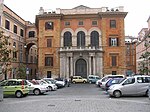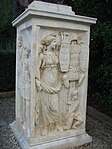Palazzo Muti

The Palazzo Muti (officially the Palazzo Muti e Santuario della Madonna dell' Archetto) is a large townhouse in the Piazza dei Santi Apostoli, Rome, Italy, built in 1644. Together with the neighboring Palazzo Muti Papazzurri, it originally formed part of a complex of adjoining palazzi and other houses owned by the Muti Papazzurri family. During the 18th century this entire range of buildings was, by courtesy of the Pope, the residence of the exiled Stuart dynasty while in exile in Rome. They were recognised by the Catholic Church as the rightful kings of Great Britain and Ireland. The Palazzo Muti should not be confused with the Palazzo Muti Papazzurri in the Piazza della Pilotta which was designed by Mattia de' Rossi in 1660.
Excerpt from the Wikipedia article Palazzo Muti (License: CC BY-SA 3.0, Authors, Images).Palazzo Muti
Via del Vaccaro, Rome Municipio Roma I
Geographical coordinates (GPS) Address Nearby Places Show on map
Geographical coordinates (GPS)
| Latitude | Longitude |
|---|---|
| N 41.898521 ° | E 12.482733 ° |
Address
Abruzzi
Via del Vaccaro 1
00187 Rome, Municipio Roma I
Lazio, Italy
Open on Google Maps









